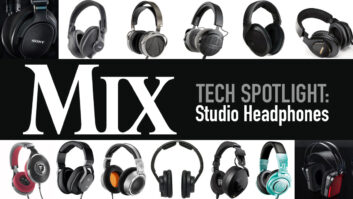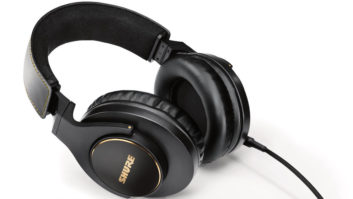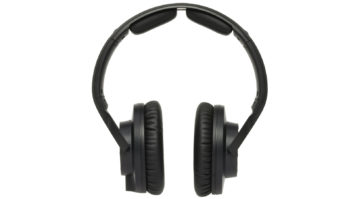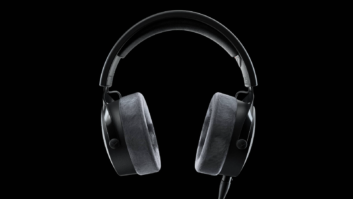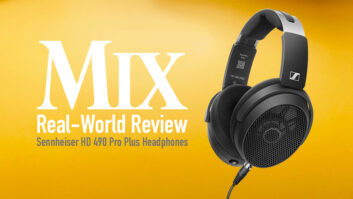
Focused as we are on Pro Audio, we don’t usually wade into the waters of commercial audio products, but when AKG invited us to the launch of its new N90Q By Quincy Jones headphones, we were intrigued. And when we learned that both Jones and Dinesh Paliwal, CEO of AKG’s parent company Harman, would be there, too? It was a done deal.
The debut, held at Harman’s flagship store on Madison Avenue in New York City, was splashy, which was only fitting for high-end headphones with a high-end price tag to match (which we’ll get to in a bit). Paliwal addressed the cost head-on, agreeing that it was considerable due to new audiophile features and technologies that had been in development for years, but that it was time to get them out into the world and figuring out how to make the price more accessible would come with time. Meanwhile, Jones used his time speaking to the crowd to praise tenacious audio engineers who wouldn’t settle for passable sound, from the AKG team present at the event to storied recording engineers of his own past such as Bruce Swedien with whom he recorded Michael Jackson’s classic albums.
And what of the headphones themselves? The N90Qs, due out September 7, 2015, are being touted as “the first headphones with personalized sound,” and much of that comes down to TruNote—a feature that customizes the headphones’ sound to the shape of each user’s ears. They self-calibrate by playing a pair of sweeping tones, measuring frequency response via two tiny mics in each ear cup, and then generating a correction filter. All this takes about five seconds. While the difference isn’t always immediately noticeable by itself, it jumps out at you if you listen to music through N90Qs after they’ve been set-up for someone else, and then apply TruNote for yourself. Ensuring that you hear all that, inside each ear cup is a pistonic-motion, 52 mm transducer that makes use of a special Japanese paper membrane, placed off-center in an effort to better align the driver and ear canal.

More personalization can be fostered by a rotary treble/bass control on the left ear, while a similar control on the right ear handles volume. Also on the right ear cup is a button that does double-duty, initiating TruNote as needed, but also rotating through DSP presets for Normal, Studio Setting (intended to sound more airy and natural), and Surround Sound Setting (a rather thick, short reverb). The N90Qs’ right ear cup also has the on/off switch. Active noise cancellation is automatically on when the headphones are running, but that said, it’s surprisingly quiet of its own accord; while you can pick out the high-pitched hiss often associated with noise-cancelling headphones, it’s considerably quieter than other manufacturers’ models with which I’m familiar.
Rounding out the right ear cup is a 1/8-inch input jack, and also a Micro USB port; users who connect directly via USB to a computer can get digital audio playback through a built-in 96 kHz DAC, removing an extra digital audio conversion step. The Micro USB port also doubles as a charging input, allowing users to juice up the headphones’ internal battery. The headphones additionally come with an AKG N Series Powerbank—an external backup battery that can be plugged into the headphones via the provided USB cord.
The ear cups are made of comfortable leather and thick, dual-density foam, doing a nice job on their own of muting the outside world even before noise cancellation is factored in. The headphones themselves are made of lots of solid aluminum with a moderate amount of weight—at 460 g, it’s enough to make the N90Qs feel substantial, but not enough to fatigue one’s neck or head when wearing them. Additional accessories provided include a hard metal/rubber carrying case, travel pouch, Powerbank pouch, various cables and numerous adaptors.

Given a pair to test-drive, the N90Qs undoubtedly sound very nice. Playing a variety of genres through them, the headphones handled all well but really shined with a little experimentation. For instance, the DSP presets lend themselves differently to various genres. On one hand, the Surround Sound setting added pleasant ambiance to a Speakers Corner vinyl repressing of Duke Ellington and Johnny Hodges’ 1959 small-combo album, Side By Side; alternately, the Studio Sound setting seemed best for playing bombastic mid-’80s rock like Simple Minds, as the Surround setting’s additional reverb didn’t add much to tracks that were already awash in the stuff. Keeping the setting on Normal is a real option, however—the headphones can still hold their own without the DSP. That’s fitting, however, since the Normal setting is intended for reproducing sound from already-effected sources like DTS Headphone:X.
Changes made by the rotating bass/treble control were very smooth and less drastic than might be expected—and that might have to do with Quincy Jones, as the feature was reportedly insisted on by and developed with the mega-producer himself.
The only real drawback to the N90Qs is that they make some rather piercing sounds—a loud, head-splintering crack as they come online, and three differently pitched “wooden block” sounds emitted by the bass/treble control to tell users whether they’re dealing with bass, center or treble. The sounds, while helpful, made my head ring enough that I didn’t use the control if I could help it, and I avoided putting the headphones on until they’d fully powered up and “cracked.”
Another issue is a lack of documentation for various battery-related matters. While a Harman spokesperson informed me that the headphones hold a 12-hour charge, it’s not mentioned in the various user guides, nor is there information as to how long the headphones or Powerbank should be charged. Intriguingly, there’s one end of a Micro USB cable inside the hard case which leads into the case’s packaging—and on the outside of the case, there’s a built-in Micro USB port. However, neither appears to do anything, so it’s unclear if the case itself is meant to contain a battery as well, or (more likely) act as a pass through, allowing users to charge the headphones from the Powerbank with the case closed. When we find out, we’ll update this story with the info.
Because of the customization features, the N90Qs aren’t really for—or adaptable to—studio use, and the price tag of $1,500 also ensures that they won’t be added to recording facility equipment lists anytime soon. But while they’re not meant for audio professionals at work, they provide plenty of opportunity for those same professionals to finesse sound when enjoying music in real life.
If you’re the sort for whom listening to music is an participation sport, the N90Qs provide ample opportunity to satisfy your inner control freak.
